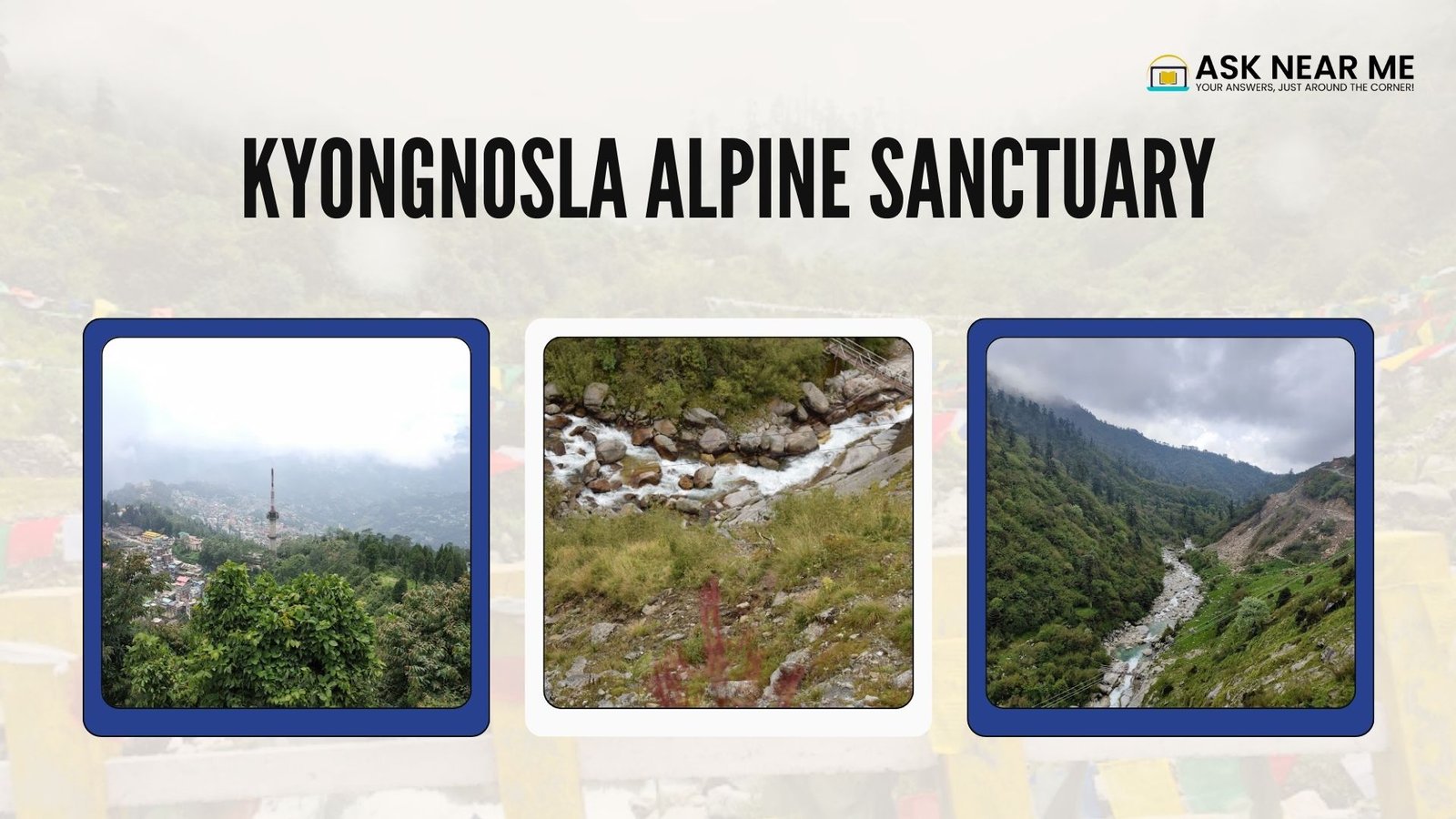Kyongnosla Alpine Sanctuary, nestled in East Sikkim, India, stands as a testament to the region’s rich biodiversity and natural splendor. Situated adjacent to the picturesque Tsomgo (Changu) Lake along the Nathula Road, this sanctuary offers visitors a captivating glimpse into the pristine Himalayan landscape. Spanning over an area of approximately 31 square kilometers, this sanctuary offers visitors a unique opportunity to immerse themselves in the natural beauty of the Eastern Himalayas.
Location and Accessibility
Proximity to Gangtok
Located approximately 31 kilometers (19 mi) east of Gangtok, the capital of Sikkim, Kyongnosla Alpine Sanctuary is easily accessible for tourists seeking to explore its diverse flora and fauna. The sanctuary covers an area of about 31 square kilometers (12 sq mi), extending from the “15th Mile” police checkpoint up to the ridges bordering the Rong Chu Valley and Lake Tsomgo.
Ecological Significance
Rich Biodiversity
Kyongnosla Alpine Sanctuary boasts a rich tapestry of flora and fauna, with rare and endangered species dotting its landscape. Ground orchids and rhododendrons, interspersed among towering junipers and silver firs, add to the sanctuary’s ecological significance and aesthetic appeal.
Conservation Efforts
The sanctuary serves as a vital refuge for endangered plant species, including the Rhododendron niveum (the State Tree of Sikkim) and Cypripedium tibeticum (the ground slipper orchid), which are on the verge of extinction. By introducing these species into the sanctuary, conservationists aim to safeguard their survival and preserve Sikkim’s botanical heritage.
Visitor Information
Best Time to Visit
For an optimal experience, visitors are encouraged to explore Kyongnosla Alpine Sanctuary during the months of May, June, October, and November. During these periods, the climate is pleasant, dry, and warm, providing ideal conditions for wildlife viewing and nature walks amidst the sanctuary’s serene surroundings. Autumn, from September to November, is also an excellent time to visit, offering clear skies and stunning views of the surrounding mountains.
Attractions and Activities:
- Alpine Flora: Kyongnosla Alpine Sanctuary is home to a rich variety of alpine flora, including rare and endemic species such as primulas, rhododendrons, and orchids. Visitors can explore the sanctuary’s lush meadows and forested slopes to admire these floral wonders.
- Wildlife Viewing: The sanctuary is inhabited by diverse wildlife species, including red pandas, Himalayan black bears, musk deer, and numerous bird species. Wildlife enthusiasts can embark on guided treks and nature walks to spot these fascinating creatures in their natural habitat.
- Scenic Beauty: The sanctuary offers breathtaking vistas of snow-capped peaks, crystal-clear streams, and verdant valleys, making it a paradise for photographers and nature lovers.
- Birdwatching: Kyongnosla Alpine Sanctuary is a haven for birdwatchers, with a plethora of avian species to be spotted, including Himalayan monals, blood pheasants, and various species of finches and thrushes.
Weather Condition: The weather in Kyongnosla Alpine Sanctuary varies with the seasons. Summers are mild and pleasant, with temperatures ranging from 10°C to 20°C during the day. Winters are cold, with temperatures dropping below freezing, and occasional snowfall at higher elevations. Monsoon season, from July to August, brings heavy rainfall, which may affect accessibility and outdoor activities.
Local Events and Festivals: While there are no specific events or festivals held within Kyongnosla Alpine Sanctuary, visitors can immerse themselves in the vibrant cultural scene of Sikkim by attending local festivals and events in nearby towns and villages. Losar (Tibetan New Year), Saga Dawa, and Pang Lhabsol are some of the major festivals celebrated in Sikkim.
Local Cuisine: Visitors to Kyongnosla Alpine Sanctuary can savor authentic Sikkimese cuisine at nearby eateries and restaurants. Local delicacies include momos (dumplings), thukpa (noodle soup), gundruk (fermented greens), and traditional Sikkimese tea, providing a delicious culinary experience.
Sustainable Tourism Practices: Kyongnosla Alpine Sanctuary promotes sustainable tourism practices to conserve its fragile ecosystem and minimize environmental impact. Initiatives include waste management, responsible tourism guidelines, and community-based conservation efforts involving local communities.
Safety: While Kyongnosla Alpine Sanctuary is relatively safe for visitors, it’s essential to take necessary precautions while exploring the wilderness. Visitors should stay on designated trails, carry sufficient water and supplies, and be aware of weather conditions and altitude sickness.
Language: The primary languages spoken in Sikkim are Nepali, Bhutia, and Lepcha. English and Hindi are also widely understood, facilitating communication with locals and tour guides.
Local Culture and Customs: Sikkim’s culture is deeply influenced by Tibetan, Nepalese, and indigenous traditions, reflected in its festivals, music, dance, and religious rituals. Visitors are encouraged to respect local customs, such as seeking permission before photographing locals and refraining from littering in the sanctuary.
Transportation: Kyongnosla Alpine Sanctuary is located approximately 30 kilometers from Gangtok, the capital city of Sikkim. Visitors can reach the sanctuary by hiring taxis or private vehicles from Gangtok, which takes about an hour’s drive.
Health Check: Visitors to Kyongnosla Alpine Sanctuary are advised to consult a healthcare professional regarding vaccinations and health precautions, especially if planning to trek or hike in the sanctuary. It’s advisable to carry essential medications, insect repellents, and first aid supplies.
Nearby Places to Eat and Stay Accommodation: Accommodation options near Kyongnosla Alpine Sanctuary include guesthouses, homestays, and resorts in nearby towns such as Gangtok and Tsomgo. These accommodations offer comfortable lodging and delicious meals, allowing visitors to relax and rejuvenate after a day of exploration in the sanctuary. Additionally, there are small eateries and tea stalls offering local snacks and refreshments for visitors to enjoy during their visit.
Visiting Kyongnosla Alpine Sanctuary promises an unforgettable experience amidst the pristine beauty of the Eastern Himalayas, providing a glimpse into the diverse flora and fauna of this enchanting region.
Conclusion
With its breathtaking landscapes, rich biodiversity, and commitment to conservation, Kyongnosla Alpine Sanctuary offers visitors an unparalleled opportunity to immerse themselves in the natural wonders of Sikkim’s Eastern Himalayas. Whether admiring rare orchids, trekking along scenic trails, or simply reveling in the sanctuary’s tranquil ambiance, a visit to Kyongnosla promises an unforgettable experience amidst the splendor of the Himalayan wilderness.
If you like this, you may also like reading Maenam Wildlife Sanctuary: Exploring Sikkim’s Rich Biodiversity

